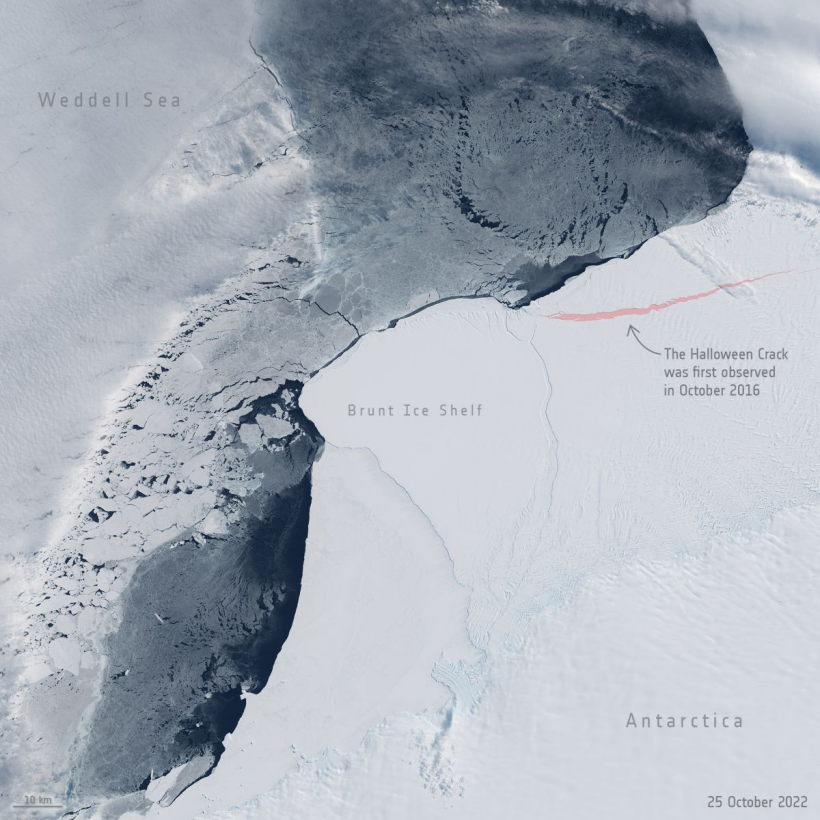The "Halloween Crack" (colored red) is seen along an unstable portion of the Brunt Ice Shelf in the Antarctic region. On October 25, 2022, it was picked up by the European Space Agency's Copernicus Sentinel-2 satellite. (Image credit: Copernicus Sentinel (2022) data updated by ESA, CC BY-SA 3.0 IGO)
New satellite data reveal an unsettling 'Halloween Crack' adjacent to an Antarctic glacier shelf that would be 'hanging by a thread.' The crevasse on its own is stable, but the neighboring tip of the Antarctic ice shelves is a worry as the southernmost peninsula continues to melt owing to climatic changes, as stated by the European Space Agency (ESA). According to new satellite data, the top of the shelf is supported only by a thin strand of ice approximately one-third of a mile (600 meters) long.
When and if this is possible during another ultimate break, it is projected to result in the formation of a massive iceberg covering around 1,750 square kilometers." [675 square miles]," wrote ESA officials, which is five times greater than the landmass of Malta." (Malta is around 10 times the size of Rhode Island, the smallest state in the United States.)
The Spotting of the Crack
Recent imagery from Europe's Copernicus Earth Observation Program's Sentinel-2 satellite mission may help anticipate the related rise in Earth's ocean levels if the perilous tip crashes into the neighboring Weddell Sea, according to Geeky News.
The Halloween Crack was discovered on October 31, 2016, and runs from an area called McDonald Ice Rumples, which is where the bottom of the moving ice sheet is anchored on the shallow seafloor. This anchoring point inhibits the flow of ice as well as splits the ice surface.
Because ice shelves float, calving icebergs do not contribute to sea-level rise. However, ice shelves function as a brake on how quickly glaciers on land stream to the sea. Because of climate change, Antarctica's ice shelves are diminishing, increasing the likelihood of more ice cover washing up in the oceans and contributing to sea-level rise, which is perhaps more terrifying than Halloween.
The analysis of such an iceberg is a component of a larger collection of satellite studies of Antarctica, which is relatively distant but yet within reach of observatories, which can detect "changes in ice movements, air, and ocean conditions," according to ESA.

A "Halloween Crack" (shaded in red) is visible near an unstable region of Antarctica's Brunt Ice Shelf. It was imaged by the European Space Agency's Copernicus Sentinel-2 satellite on Oct. 25, 2022.
Decades of Iceberg Losses
NASA JPL scientists merged over 3 billion points of information from seven spaceborne altimetry equipment to create the longest continuous data collection on the changing altitude of the ice sheet - an indication of ice loss - dating back to 1985. They employed radar and laser assessments of ice height to construct the largest monthly maps of ice loss ever made.
The unprecedented clarity in the new dataset indicates how long-term patterns and yearly weather patterns impact the ice. It even depicts the ice sheet's rise and fall as subglacial lakes fill and empty kilometers under the surface.
Subtle shifts such as this, along with a better knowledge of long-term patterns from this data collection, will allow scientists to comprehend the mechanisms that impact ice loss, allowing for more accurate future projections of sea level rise, remarked by JPL's Johan Nilsson, the study's principal author.
Synthesizing and evaluating the huge archives of observations into a unified, high-resolution data set takes years of labor and hundreds of hours of processing time on NASA's servers. Condensing the data into anything more generally usable may get humanity closer to the huge discoveries scientists require to better comprehend the planet and ultimately help prepare mankind for the future implications of climate change, Nilsson concludes.
RELATED ARTICLE: Earth Scientists Discover the Most Suspenseful Iceberg of the World is Breaking Apart
Check out more news and information on Climate Change in Science Times.














